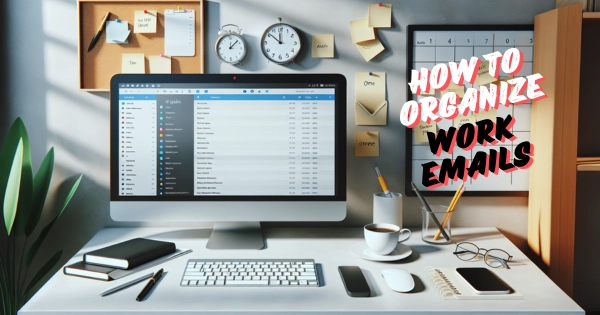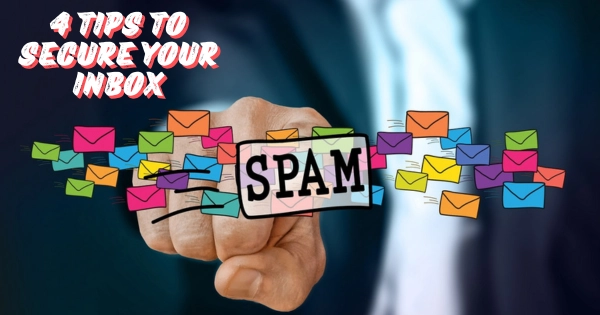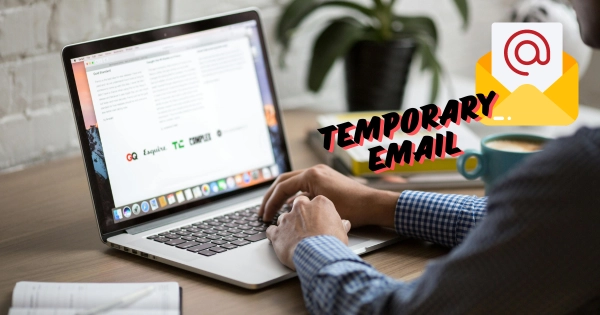Ever opened your inbox to find hundreds of unread emails? It's overwhelming, right?In this post, I'll help turn your email nightmare into a dream.
We're going to go over foolproof tactics to organize your work emails that have drastically improved my daily productivity. Step into a more organized world with me. Get ready to see your inbox (and your day) in a whole new light!
Organizing work emails is pivotal for enhancing productivity and ensuring a clutter-free inbox, which, in turn, facilitates the quick location of important messages and boosts efficiency levels7. This process involves sorting, prioritizing, and categorizing emails effectively to maximize workplace productivity and reduce stress associated with email overload7.
Utilizing tools like Gmail, Outlook, and Front, which offer various features for email management, can significantly improve the organization of work emails. These platforms provide solutions that cater to organizing free business email with domain and google business email, among others, making them essential for businesses aiming to streamline their email management practices9.
Set Specific Times for Email Management
Schedule Specific Times for Email Checks
1. Designate Fixed Times for Email Review
To enhance focus and productivity, establish specific times during the day for checking emails. This practice helps in prioritizing messages based on their importance and urgency 5421.
2. Limit Email Checks
Reducing email checks to just three times a day can significantly boost productivity and lower stress levels. This method ensures that you spend more time on meaningful tasks rather than constant email monitoring 10.
3. Optimal Timing for Email Management
Schedule a 30-minute slot at 2 PM for checking emails. This timing can be particularly effective as it aligns with the natural post-lunch energy dip, providing a structured break that can help in regaining focus 11.
4. Hourly Checks Versus Every 37 Minutes
Adjusting your email checking frequency from every 37 minutes to hourly can reduce the number of checks by six per day, thus saving time and minimizing distractions 12.
5. Turn Off Notifications
To avoid constant interruptions, turn off real-time notifications and instead check emails only during the scheduled times. This approach helps in maintaining concentration on current tasks 12.
6. Accountability in Email Management
By setting a specific time to manage emails, you can hold yourself accountable and stay organized. This schedule aids in handling emails efficiently without them becoming a disruption 13.
7. Implement Email Sprints
Begin your day with a 20-25 minute email sprint to tackle the more complex emails. This focused time allows for making quicker and more informed decisions early in the day 14.
8. Adherence to Scheduled Times
Consistently checking emails at the predetermined times can streamline your workflow and reduce the urge to constantly monitor your inbox 8.
Utilize Labels and Folders for Organization
Creating and Managing Labels in Gmail
1. Creating a New Label:
To create a label in Gmail, access Gmail on your computer, scroll down on the left side, click "More", and then select "Create new label" 15.
2. Adding a Label to an Email:
For adding a label to an email, open Gmail, select the message, click "Labels" at the top, and then either select an existing label or create a new one 15.
3. Moving Messages Between Labels:
To move an email to a different label, select the message, click "Labels", uncheck the current label, select a new label, and click "Apply" 15.
4. Editing or Deleting Labels:
Labels can be modified or removed by hovering over the label’s name, clicking "More", and selecting "Edit label" or "Remove label" 15.
5. Color-Coding Labels:
For easier identification, labels can be color-coded within Gmail settings 16.
6. Visibility of Labels:
You can choose to show or hide labels in the Gmail menu to streamline your interface 15.
Utilizing Folders and Automation
1. Using Folders and Tags:
Employ folders, labels, or tags to categorically organize incoming emails, enhancing retrieval efficiency 8.
2. Priority Icons and Automation:
Implement priority icons for crucial emails and set up rules or automations for sorting emails automatically, saving time and maintaining focus 8.
3. The 5-Folder Method:
Organize emails into five folders: Inbox, Today, This Week, This Month, and FYI, to prioritize and manage the flow of information 8.
4. Waiting Folder Strategy:
Move emails that require a follow-up or are pending action into a 'Waiting' folder to keep track of ongoing tasks 8.
Advanced Label Management with Gmelius
1. Team Collaboration with Gmelius:
Gmelius allows sharing of labels with team members, promoting transparency and collective responsibility in email management 17.
2. Automating Labels with Filters:
Set filters to automatically add labels to incoming emails, facilitating immediate sorting and categorization 17.
3. Gmelius Free Trial:
Explore Gmelius features with a 7-day free trial, enabling you to test its capabilities in real-time without any upfront commitment 17.
By implementing these strategies, you can significantly enhance your email organization, making your inbox a tool for productivity rather than a source of stress.
Implement the Two-Minute Rule for Immediate Actions
Understanding the Two-Minute Rule
The Two- nanosecond Rule, conceptualized by David Allen in his book" Getting effects Done," is a important tool for managing work emails efficiently 18. This rule simplifies decision- making about whether to respond to an dispatch incontinently or postpone it. Then’s how to apply this rule effectively:
1. Initial Assessment: Quickly scan each email to determine if it requires a response. If the response can be completed in under two minutes, handle it immediately 1819.
2. Immediate Action: For emails that can be responded to quickly (e.g., confirmations, short answers), take action right away. This prevents these tasks from piling up and helps keep your inbox clear 19.
3. Defer Complex Tasks: If an email requires more than two minutes, flag it for follow-up. This allows you to focus on more demanding tasks without losing track of what needs to be addressed later 18.
4. Use of Tools: Implement email management tools and templates to speed up the response time for frequent inquiries or common email types 5421.
5. Task Prioritization: Employ the Two-Minute Rule to prioritize tasks, ensuring that quick tasks are completed promptly, which can significantly boost overall productivity 21.
6. Managing Mental Load: By dealing with simpler emails quickly, you reduce the mental burden of an overflowing inbox, which can enhance focus on more significant projects 20.
7. Setting Boundaries: If the task is actionable and important but requires more extensive effort, schedule a specific time to handle these emails, thus avoiding immediate context switching 22.
By integrating the Two-Minute Rule into your daily email management routine, you not only keep your inbox under control but also enhance your productivity by focusing on tasks that require more attention and time.
Unsubscribe from Unnecessary Emails
Regular Inbox Maintenance
1. Regularly Clean Your Inbox: Make it a habit to regularly clean out your inbox to avoid accumulation of unwanted emails. Unsubscribe from newsletters and promotional emails that no longer serve your interest or need 654321.
2. Practice Digital Hygiene: Keep your inbox clean by regularly deleting old emails and unsubscribing from email lists that clutter your inbox 51.
Utilizing Unsubscribe Tools
1. Use Unsubscribe Tools: Tools like Unroll.me can be very effective in managing your email volume by clustering less-important messages together. This allows for easier bulk management 14.
2. Manual Unsubscribe: For unwanted emails, scroll to the footer and look for the "unsubscribe" link. Clicking this link should remove you from the sender's distribution list 23.
3. Verify Before Unsubscribing: Before hitting “unsubscribe,” hover your mouse over the sender’s address to verify its authenticity. If it looks suspicious, it's safer to direct the email to your spam folder 24.
Handling Spam and Phishing Emails
1. Identify Spam or Phishing: If you suspect an email might be spam or a phishing attempt, avoid clicking on any links or downloading attachments. Instead, direct these emails to the spam folder 24.
2. Effective Unsubscribing: Unsubscribing from a legitimate sender's list can reduce email volume and signal to the sender that the address is no longer active or valid. However, be cautious as some spam emails may use fake unsubscribe links 24.
3. Separate Email for Subscriptions: To reduce spam, consider using a separate email address for online subscriptions and accounts. This keeps your primary account cleaner and more manageable 24.
Advanced Email Management
1. Yahoo’s Spam Management: Yahoo Mail users benefit from its capability to automatically filter out emails from previously marked spam sources, enhancing inbox management 24.
2. Regular List Cleaning: Make it a routine to unsubscribe from unwanted mailing lists and categorize necessary emails into appropriate folders or labels to keep your primary email streamlined and organized 824.
Conclusion
Through the implementation of strategic approaches to email organization, such as scheduling email checks, employing labels and folders, integrating the Two-Minute Rule, and diligently unsubscribing from unnecessary communications, individuals are granted the opportunity to transform their inboxes into efficient tools that bolster productivity rather than sources of stress. These methodologies, supported by tools like Gmail, Outlook, and Front, leverage technology not only to simplify email management but also to enhance overall work efficiency and mental clarity in a professional setting. The importance of managing work emails effectively cannot be overstated, as it directly contributes to a more organized, less cluttered digital environment conducive to higher levels of focus and productivity.
Recognizing the broader implications of these practices, it is evident that mastering email organization extends beyond mere inbox management, shaping a mindset oriented towards efficiency and proactive handling of daily tasks. Such skills are indispensable in the modern digital workplace, where the ability to swiftly navigate, prioritize, and respond to emails can significantly affect one's professional success and well-being. As businesses and individuals continue to seek methods to improve productivity and reduce digital overload, the principles outlined herein serve as a comprehensive guide. Therefore, readers are encouraged to integrate these strategies into their workflows, continually refine their email management techniques, and explore further research or tools that can aid in maintaining an optimal level of productivity.
References
[1] - https://missiveapp.com/blog/email-management-best-practices
[2] - https://zapier.com/blog/outlook-tips-and-tricks/
[3] - https://lockrmail.com/6-email-organization-tips-to-amp-up-productivity/
[4] - https://www.mailbutler.io/blog/email/email-productivity-tips/
[5] - https://www.wisestamp.com/blog/email-management/
[6] - https://blog.hubspot.com/marketing/inbox-organization-tools
[7] - https://www.indeed.com/career-advice/career-development/email-organization
[8] - https://front.com/guides/manage-work-email
[9] - https://www.washingtonpost.com/technology/2022/07/21/how-to-manage-work-emails/
[10] - https://medium.com/@andy.liu.ad21/how-to-check-your-work-email-only-3-times-a-day-b956a4a099fd
[11] - https://thelbdgroup.com.au/the-best-time-of-day-to-check-email/
[12] - https://hbr.org/2019/01/how-to-spend-way-less-time-on-email-every-day
[13] - https://www.topresume.com/career-advice/when-you-should-and-shouldnt-check-your-email
[14] - https://hbr.org/2016/03/actually-you-should-check-email-first-thing-in-the-morning
[15] - https://support.google.com/mail/answer/118708?hl=en&co=GENIE.Platform%3DDesktop
[16] - https://www.youtube.com/watch?v=3P6GKMpGSFg
[17] - https://www.youtube.com/watch?v=88l0_Lz7OZQ
[18] - https://www.thinkingdirections.com/tame-email-with-the-2-minute-rule/
[19] - https://toniakendrick.com/2-minute-rule/
[20] - https://www.usemotion.com/blog/2-minute-rule
[21] - https://www.mytimemanagement.com/the-two-minute-rule-for-email.html
[22] - https://todoist.com/inspiration/two-minute-rule
[23] - https://www.reddit.com/r/techsupport/comments/pneqek/keep_my_getting_spam_emails_but_cant_unsubscribe/
[24] - https://www.quora.com/Does-the-unsubscribe-option-in-junk-email-really-work-and-helpful-to-get-off-the-list-or-is-it-fake
[25] - https://www.themuse.com/advice/i-check-email-all-day-every-day-and-im-more-productive-because-of-it


